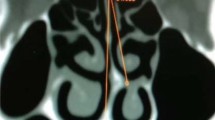Abstract
Rhinosinusitis is an extremely prevalent disorder that has a significant impact on the quality of life of affected individuals. Nasal septal deviation may either cause osteomeatal obstruction or may interfere with proper airflow and potentially predispose to sinusitis. This study was aimed to find
-
The incidence of various types of DNS and
-
To find co relation between NSD and sinus pathology
This work was done on 100 cases with clinical features of deviated nasal septum and co existing features of rhinosinusitis. Detailed nasal endocopic examination was done. DNS was classified according to Mladina system of classification. CT PNS was done in all cases and rhinosinusitis documented according to Lund–Mackay scoring system. Finally an attempt was made to correlate DNS and Rhinosinusitis.Type II and Type I deviations were the most common types of septal deviations found. 84% of the patients with DNS had rhinosinusitis. There was a statistically significant correlation between nasal septal deviation and rhinosinusitis with p value ≤ 0.05. Our study also significantly correlates the predisposition of rhinosinusitis on the same side as DNS. We hereby conclude that in a case of DNS, co-existent rhinosinusitis should be ruled out, first by detailed history taking and then if warranted by CT-PNS. Such chronic patients treated by septoplasty alone may never be relieved of their symptoms. Thus combined septopasty and FESS is advisable.



Similar content being viewed by others
References
Poorey VK, Gupta N (2014) Endosopic and CT evaluation of influence of nasal septal deviation on lateral wall of nose and its relation to sinus diseases. Indian J of Otolaryngol Head Neck Surg 41:103–106
Passali D, Ferri R, Becchini G, Passali C, Bellussi L (1999) Alterations of nasal mucociliary transport in patients with hypertrophy of the inferior turbinates, deviations of the nasal septum and chronic sinusitis. Eur Arch Otorhinolaryngol 256:335–337
Kern RC, Liddy W (2015) Rhinosinusitis. Flint PW, Lund V, Thomas JR, Robbins KT et al. Cummings otolaryngol head neck surgery, 2nd ed. Elsevier, Amsterdam, pp 837–841
Llyod GAS, Lund VJ, Scadding GK (1991) CT of the paranasal sinuses and functional endoscopic surgery: a critical analysis of 100 symptomatic patients. J Laryngol Otol 105:181–185
Watelet JB, Van Cauwenberge P (1999) Applied anatomy and physiology of the nose and paranasal sinuses. Allergy 54(57):14–25
Meserklinger W (1978) Endoscopy of the nose. Urban and Schwarzenberg, Baltimore
Smith K, Edwards P, Saini T, Norton N (2010) The prevalence of concha bullosa and nasal septal deviation and their relationship to maxillary sinusitis by volumetric tomography. Int J Dent 2010:1–5
Mendiratta V, Baisakhiya N, Singh D, Datta G, Mittal A, Mendiratta P (2015) Sinonasal anatomical variants: CT and endoscopy study and its correlation with extent of disease. Indian J Otolaryngol Head Neck Surg 68(3):352–358
Prasad S, Varshney S, Bist SS, Mishra S, Kabdwal N (2013) Correlation study between nasal septal deviation and rhinosinusitis. Indian J Otolaryngol Head Neck Surg 65(4):363–366
Atik Ahmed M, Kanmadi S (2015) Role of computed tomography in evaluation of congenital anatomical variations in paranasal sinuses. Int J Biol Med Res 6(1):4775–4781
Mohebbi A, Ahmad A, Maryam E, Manouchehr S, Shadi G (2012) An epidemiologic study of factors associatedwith nasal septum deviation by computed tomography scan: a cross sectional study. BMC Ear Nose Throat Disord 12:1–5
Chaitanya CS, Raviteja A (2015) Computed tomographic evaluation of diseases of paranasal sinuses. Int J Recent Sci Res 6(7):5081–5085
Suri N, Janardhan T, Parmar H (2016) Correlation of anatomical variations of paranasal sinuses and chronic rhinosinusitis. Int Arch Integr Med 3(12):84–88
Acknowledgements
I would like to extend my thanks to my mentor Dr. Ginni Datta for her support and guidance throughout this tedious task. I would also like to give thanks to Dr. Gurchand Singh for his guidance during this endeavor.
Funding
No funding sources.
Author information
Authors and Affiliations
Corresponding author
Ethics declarations
Conflict of interest
The authors decare that they have no conflict of interest.
Ethical Approval
The study was approved by the Institutional Ethics Committee.
Additional information
Publisher's Note
Springer Nature remains neutral with regard to jurisdictional claims in published maps and institutional affiliations.
Rights and permissions
About this article
Cite this article
Rao, N., Datta, G. & Singh, G. To Study the Role of Nasal Septal Deviation and Its Relation to Sinonasal Pathology. Indian J Otolaryngol Head Neck Surg 74 (Suppl 2), 755–759 (2022). https://doi.org/10.1007/s12070-020-01800-5
Received:
Accepted:
Published:
Issue Date:
DOI: https://doi.org/10.1007/s12070-020-01800-5




